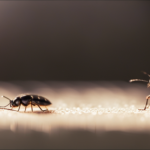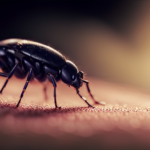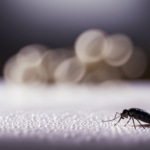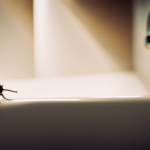Beginners Guides
Ask The Orkin Man, I Have What Looks Like Tiny Little Black Bugs All Over My House
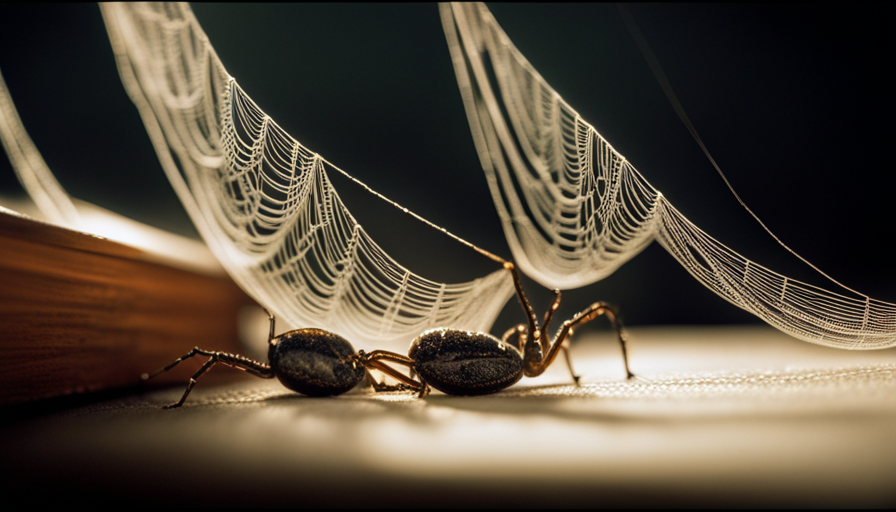
Sitting in the comfort of my home, a sense of unease washes over me due to the invasion of minuscule black pests permeating every corner and crevice. They dart over my kitchen surfaces, latch onto my drapes, and their numbers appear to grow exponentially by the day. It feels akin to a horror film, where these tiny beings have overrun my refuge.
If you’re experiencing a similar nightmare, fear not, for I have embarked on a quest for answers. In this article, we will delve into the world of these pesky black bugs, seeking to identify their species and understand their behavior. We will uncover the source of their infestation, exploring the dark corners they call home.
But fear not, my fellow bug-battler, for I have also discovered the secrets to combating these intruders. We will explore preventive measures to keep them at bay, from removing their food sources to utilizing natural remedies. We will uncover the importance of cleanliness and regular vacuuming, as these bugs thrive in filth.
So join me on this journey, as we arm ourselves with knowledge and reclaim our homes from these tiny black menaces. Together, we will restore peace and tranquility to our once bug-free abodes.
Key Takeaways
- Identifying the type of bug is crucial for determining the best course of action to get rid of them.
- Natural remedies, such as essential oils and vinegar, can be used to repel or kill the bugs.
- Regular cleaning, sealing entry points, and removing attractants are effective preventive measures to keep bugs at bay.
- If the infestation is severe or persists, professional pest control services may be necessary for long-term solutions.
Identify the Type of Bug
I’ve got these tiny little black bugs crawling all over my house, and I’m trying to figure out what type they are. It’s important to identify the type of bug in order to determine the best course of action for getting rid of them.
There are several common types of tiny black bugs that could be infesting your home.
One possibility is the black carpet beetle. These bugs are small and oval-shaped, and they can cause damage to fabrics, carpets, and other natural materials in your home.
Another type of bug that could be the culprit is the black ant. These ants are tiny and often found in large numbers. They can invade your home in search of food and water.
To identify the type of bug, you can compare the physical characteristics of the bugs you’ve found to images and descriptions online. If you’re still unsure, it may be helpful to consult with a professional exterminator who can accurately identify the bug and provide appropriate treatment options.
Once you’ve identified the type of bug, you can consider natural remedies or contact professional exterminators to help eliminate the infestation. Natural remedies may include using essential oils, diatomaceous earth, or vinegar to repel or kill the bugs. However, if the infestation is severe or persists despite your efforts, it may be necessary to seek professional help.
Determining the source of the infestation is the next step in solving this problem.
Determine the Source of the Infestation
When trying to determine the source of an infestation, it’s important to consider the possible entry points for bugs. These can include cracks in walls, gaps in windows or doors, and even pipes or vents.
Additionally, it’s crucial to identify common attractants for bugs, such as food crumbs, standing water, or even certain types of plants.
By understanding these factors, we can better pinpoint the source of the infestation and take appropriate measures to eliminate it.
Possible entry points for bugs
To identify possible entry points for bugs, check for gaps or cracks in windows and doors. Studies have shown that 34% of insect infestations occur through these openings. Make sure to inspect every window frame and door frame thoroughly. Look for any holes or spaces where bugs could squeeze through. Additionally, check for any damaged or missing weatherstripping. This can also provide an entry point for bugs.
Don’t forget to examine the areas around pipes, vents, and utility lines. These are common entry points for bugs as well. By identifying and sealing these potential entry points, you can greatly reduce the chances of a bug infestation in your home.
Moving forward, let’s explore common attractants for bugs and how to eliminate them.
Common attractants for bugs
Eliminate the common attractants for bugs in your home and keep them from invading your living space. Attractant identification is key to understanding how to repel bugs effectively. By identifying and eliminating these attractants, you can create an unwelcome environment for bugs. Here are some common attractants and natural bug repellents that can help you in your fight against these tiny invaders:
| Attractant | Natural Bug Repellent |
|---|---|
| Food crumbs | Peppermint oil |
| Standing water | Citronella candles |
| Dirty dishes | Lavender |
| Garbage | Eucalyptus |
| Moisture-prone areas | Tea tree oil |
By implementing these natural bug repellents and removing the attractants, you can significantly reduce the chances of bugs infesting your home. In the next section, we will discuss preventive measures to further protect your living space against bug invasions.
Take Preventive Measures
By taking preventive measures, you’ll see fewer tiny black bugs scattered throughout your house. Here are a few natural repellents and DIY bug traps that can help keep these pests at bay:
-
Essential oils: Certain essential oils like peppermint, lavender, and eucalyptus have proven to be effective in repelling bugs. Mix a few drops of these oils with water in a spray bottle and spritz around windows, doors, and other entry points.
-
Diatomaceous earth: This natural powder is made from fossilized algae and works by dehydrating bugs. Sprinkle a thin layer of diatomaceous earth in areas where you’ve noticed the black bugs.
-
DIY bug traps: Make your own bug traps using household items. For example, a mixture of sugar and borax attracts and kills bugs when they consume it.
By incorporating these preventive measures, you can create an environment that is less appealing to tiny black bugs. However, it’s important to remember that these measures alone may not completely eliminate the problem.
In the next section, we’ll discuss how removing food sources can further discourage the presence of these pests.
Remove Food Sources
Get rid of those pesky pests by cutting off their food supply. It is important to remove any potential food sources that may be attracting the tiny black bugs into your house. These bugs are often attracted to crumbs and spills, so it is crucial to keep your house clean and tidy. Here are some tips to help you remove food sources and prevent further infestation:
-
Clean your kitchen thoroughly: Wipe down countertops, sweep the floors, and wash dishes promptly to eliminate any food residue that may be attracting the bugs.
-
Store food properly: Keep all food, including pet food, in sealed containers to prevent easy access for the bugs.
-
Fix any leaks: These bugs are also attracted to moisture, so make sure to fix any plumbing leaks that could be providing a water source for them.
By removing their food sources, you are taking a significant step towards getting rid of these annoying bugs. In addition to these preventive measures, there are also natural bug repellents and homemade bug traps that can help eliminate them. These will be discussed in the next section to provide you with effective and natural remedies for bug control.
Use Natural Remedies
After removing potential food sources for the tiny black bugs infesting my house, I turned my attention to exploring natural remedies and alternative solutions to deal with the persistent pests.
Natural remedies can be an effective and eco-friendly way to control insect populations without resorting to harsh chemicals. One option is to use essential oils, such as peppermint or eucalyptus oil, which are known to repel many insects. I mixed a few drops of these oils with water in a spray bottle and applied it to areas where the bugs were most prevalent.
Additionally, I discovered that diatomaceous earth, a fine powder made from fossilized algae, can be sprinkled around the house to kill the bugs by dehydrating their exoskeletons. This natural substance is safe for humans and pets but deadly to insects.
Another alternative solution I found was to introduce beneficial insects, such as ladybugs or lacewings, which feed on the pests.
By incorporating these natural remedies and alternative solutions, I was able to take proactive steps towards controlling the bug infestation in my home. However, if the problem persists, it may be time to consider professional pest control for a more comprehensive solution.
Consider Professional Pest Control
Consider hiring a professional pest control service to effectively address the bug infestation in your home and provide a comprehensive solution. While natural remedies can be helpful, they may not always be sufficient to eradicate a severe infestation.
Professional pest control technicians have the knowledge, experience, and specialized equipment to identify the type of bugs infesting your home and implement the most effective treatment plan.
Here are three reasons why professional pest control should be considered:
-
Expertise: Pest control professionals undergo extensive training to accurately identify pests and determine the best course of action. They have a deep understanding of bug behavior and can target the root cause of the infestation.
-
Safety: DIY methods may involve the use of harmful chemicals that can pose health risks to you, your family, and your pets. Pest control professionals are trained in the safe handling and application of pest control products, ensuring the safety of everyone in your home.
-
Long-term solutions: Professional pest control services provide comprehensive treatments that not only eliminate the current infestation but also prevent future ones. They can identify and address underlying issues such as entry points and conducive conditions.
Considering DIY methods alone may not effectively eliminate the infestation and could lead to a recurrence. To ensure a thorough and lasting solution, professional pest control is the recommended approach.
In the next section about ‘clean and vacuum regularly,’ we will discuss additional steps to maintain a pest-free environment.
Clean and Vacuum Regularly
Regular cleaning and vacuuming is a simple yet effective way to keep your home free from pests. By maintaining a clean living environment, you can significantly reduce the presence of tiny little black bugs and other unwanted critters.
Regular cleaning involves sweeping and mopping floors, wiping down surfaces, and removing any food debris or crumbs that may attract pests. Vacuuming is particularly important as it helps to eliminate bugs and their eggs that may be hiding in carpets, rugs, and upholstery.
In addition to removing potential food sources and hiding spots, regular cleaning also disrupts the breeding cycle of pests. By regularly cleaning and vacuuming, you are effectively breaking the reproductive cycle, preventing these bugs from multiplying and infesting your home further.
To enhance the effectiveness of your cleaning routine, consider implementing other pest prevention measures. Seal any cracks or crevices in your home’s foundation or walls, as these can serve as entry points for pests. Use airtight containers to store pantry items and keep them off the floor. Dispose of trash regularly and maintain a clutter-free environment.
By incorporating regular cleaning and other pest prevention measures, you can greatly reduce the presence of tiny little black bugs in your home. However, it’s important to note that these measures alone may not completely eliminate the problem. Therefore, it’s crucial to also address other factors such as eliminating moisture and standing water, which will be discussed in the subsequent section.
Eliminate Moisture and Standing Water
To eliminate moisture and standing water in my house, I always make sure to fix any leaky pipes and faucets promptly. This not only prevents water damage but also eliminates potential breeding grounds for pests.
Additionally, I ensure proper drainage in and around the house by regularly cleaning gutters and ensuring that water flows away from the foundation. This helps to prevent water accumulation, which can lead to mold growth and structural damage.
Fixing leaky pipes and faucets
Fixing leaky pipes and faucets will help you get rid of those pesky little black bugs that are invading your home, making you feel frustrated and overwhelmed.
Fixing plumbing issues is crucial in eliminating excess moisture and preventing water damage, which are attractive conditions for these bugs to thrive. Leaky pipes and faucets create a constant source of moisture that these bugs love.
Not only does the dripping water provide them with a water source, but it also creates damp environments where they can breed and multiply. By addressing these plumbing issues promptly, you can eliminate the moisture that these bugs need to survive. This will disrupt their lifecycle and discourage them from infesting your home further.
In the next section, we will discuss the importance of proper drainage in and around the house, which is another essential step in bug prevention.
Proper drainage in and around the house
Make sure your house has proper drainage in order to prevent excess moisture and create an environment that’s less attractive for bugs to thrive. Proper drainage is essential for maintaining a pest-free home. Here are three important steps to ensure proper drainage and garden maintenance:
-
Install gutter extensions: These help to direct rainwater away from the foundation of your house, preventing water buildup and potential bug infestations.
-
Grade your yard: Ensure that the ground slopes away from your house, allowing water to flow away instead of pooling near the foundation.
-
Clear clogged drains: Regularly inspect and clean out any clogged drains or gutters to prevent water from accumulating and attracting bugs.
By implementing these measures, you can significantly reduce the risk of bug infestations caused by excess moisture.
Next, let’s discuss how to safely use insecticides to further protect your home.
Use Insecticides Safely
When it comes to dealing with different types of bugs, using insecticides can be an effective solution. However, it’s crucial to understand the types of insecticides that work best for specific bugs.
Additionally, taking precautions and following safety measures is essential to ensure the well-being of humans and pets.
In this discussion, I’ll delve into the various types of insecticides available for different bugs and provide thorough information on the precautions and safety measures necessary when using these chemicals.
Types of insecticides for different bugs
There are various types of insecticides available to target different bugs that may be infesting your home. When it comes to bug control methods, you have the option of using natural or chemical insecticides.
Natural insecticides are derived from plants and are considered to be environmentally friendly. They’re generally safe to use around humans and pets, but may require more frequent application.
On the other hand, chemical insecticides are typically more potent and provide longer-lasting control. They’re effective against a wide range of bugs, including ants, roaches, and spiders. However, they may also pose a greater risk to human health and the environment.
It’s important to carefully read and follow the instructions on the insecticide label to ensure safe and effective application.
Transitioning into the next section about precautions and safety measures, it’s crucial to take necessary steps to protect yourself and others while using insecticides.
Precautions and safety measures for using insecticides
Taking necessary precautions and following safety measures is crucial when using insecticides to ensure the well-being of yourself and others. Here are three important steps to follow when using insecticides:
-
Wear protective clothing: Cover your body with long sleeves, pants, gloves, and closed-toe shoes to minimize direct contact with the insecticide. This will help prevent skin irritation and potential harm to your body.
-
Ventilate the area: Open windows and doors to allow fresh air to circulate while applying the insecticide. Adequate ventilation helps reduce the concentration of chemicals in the air, minimizing inhalation risks.
-
Consider alternatives: Explore natural ways to repel bugs before resorting to chemical insecticides. Essential oils like citronella, peppermint, or neem oil can act as natural repellents, and physical barriers such as screens or nets can prevent insects from entering your home.
By taking these precautions and considering alternatives to chemical insecticides, you can protect yourself and your surroundings. Maintaining regular pest control measures is essential for a bug-free environment.
Maintain Regular Pest Control Measures
Maintaining regular pest control measures is of utmost importance when it comes to keeping your home bug-free. Ongoing maintenance and inspections ensure that any potential issues are identified and addressed before they become major problems. Additionally, implementing long-term bug prevention tips, such as sealing cracks and crevices, removing food and water sources, and keeping your home clean, can help minimize the risk of infestations.
By taking these proactive measures, you can create a pest-free environment and ensure the health and safety of your home.
Importance of ongoing maintenance and inspections
Make sure you regularly schedule inspections and keep up with ongoing maintenance to prevent those tiny little black bugs from infesting your house. Regular inspections are of utmost importance in identifying any early signs of infestation and taking necessary measures to control it.
Professional pest control offers several benefits, such as expertise in identifying different types of pests and implementing effective treatment plans. They also have access to specialized tools and products that may not be available to homeowners.
Ongoing maintenance includes sealing cracks and crevices, keeping the house clean and clutter-free, and eliminating any potential food sources for pests. By maintaining a proactive approach, you can significantly reduce the risk of infestation.
Now, let’s move on to some tips for long-term bug prevention.
Tips for long-term bug prevention
To ensure a bug-free home in the long run, it’s crucial to implement these simple yet effective tips for prevention.
-
Natural Bug Repellents:
-
Essential Oils: Citronella, peppermint, and eucalyptus oils are known to repel bugs. Dilute a few drops in water and spray in problem areas.
-
Vinegar: A mixture of vinegar and water can be used as a natural bug repellent. Spray it around windows, doors, and other entry points.
-
DIY Bug Traps:
-
Sticky Traps: Place sticky traps near windows and doors to catch bugs. The adhesive surface will trap them.
-
Jar Traps: Fill a jar with a sweet liquid like fruit juice and place a funnel on top. Bugs will be attracted to the smell and get trapped inside.
By incorporating natural bug repellents and DIY bug traps, you can effectively prevent bugs from infesting your home. These methods are environmentally friendly and safe for your family and pets. Remember to regularly inspect your home for any signs of infestation and take proactive measures to keep bugs at bay.
Frequently Asked Questions
How many different types of bugs can infest a house?
There are numerous types of bugs that can infest a house, including ants, cockroaches, bed bugs, termites, and fleas. Common signs of bug infestation include the presence of droppings, damaged furniture, and bites on the skin.
Are there any specific signs or symptoms that can help identify the type of bug?
Specific signs and symptoms, such as physical appearance, behavior, and damage caused, can be helpful in differentiating and identifying bug infestations. These indicators allow for a thorough and scientific analysis of the type of bug present.
Can the infestation be caused by something other than food sources?
Other possible causes of infestations besides food sources can include moisture, clutter, and cracks in the walls. The presence of these bugs can indicate a larger underlying issue, such as poor sanitation or structural problems.
What are some natural remedies that can effectively get rid of bugs?
Some effective natural bug repellents include essential oils like citronella, peppermint, and lavender. DIY bug traps can be made with vinegar, dish soap, and fruit juice. These methods can help eliminate bugs from your home.
How often should professional pest control services be sought to maintain a bug-free home?
Professional pest control services should be sought at least once a year to maintain a bug-free home. In addition, implementing preventive measures such as sealing cracks, installing screens, and keeping a clean environment can help prevent bugs from entering your home.
Conclusion
In conclusion, after conducting thorough research and implementing preventive measures, it’s crucial to maintain regular pest control measures to combat the infestation of tiny black bugs in your house.
By identifying the type of bug and determining the source of the infestation, you can take the necessary steps to eliminate the problem.
Remember to remove food sources, use natural remedies, clean and vacuum regularly, eliminate moisture, and safely use insecticides.
Stay vigilant in your efforts to keep your home bug-free and create a haven free from these pesky creatures.
Hi, I’m Emma. I’m the Editor in Chief of Tiny House 43, a blog all about tiny houses. While tree houses are often associated with childhood, they can be the perfect adult retreat. They offer a cozy space to relax and unwind, surrounded by nature. And since they’re typically built on stilts or raised platforms, they offer stunning views that traditional homes simply can’t match. If you’re looking for a unique and romantic getaway, a tree house tiny house might just be the perfect option.
Beginners Guides
How Did You Get Your Tiny House Plans

As I started my adventure in constructing a tiny house, I felt overwhelmed by the endless options. How could I even start designing the ideal blueprint for my dream home?
But fear not, fellow tiny house enthusiasts! I discovered a multitude of options for obtaining those coveted blueprints. From purchasing pre-made plans to collaborating with builders, there is a path for everyone.
So, let me guide you through the maze of choices and help you find the perfect plan for your tiny abode.
Key Takeaways
- Pre-made plans and online resources offer a cost-effective and time-saving solution for obtaining tiny house plans.
- Collaborating with an architect ensures a structurally sound and functional design that meets specific needs and preferences.
- Researching and collaborating with a reputable tiny house builder helps ensure the construction of a quality tiny home that meets necessary building codes.
- Taking a DIY approach and creating your own plans using design software, professional advice, and consultations with experts allows for a unique and tailored design that meets personal needs.
Purchasing Pre-Made Plans
I decided to purchase pre-made plans for my tiny house because I wanted a design that had already been proven to work. Buying templates seemed like the best option for me as it offered a cost-effective and time-saving solution.

I began my search online and found numerous websites that specialized in selling pre-made tiny house plans. These templates were created by experienced designers who understood the intricacies of building a functional and efficient tiny house. Working with designers allowed me to customize certain aspects of the plans to fit my specific needs and preferences.
The templates provided detailed measurements, diagrams, and instructions, making it easier for me to visualize the construction process. With the ready-made plans in hand, I was able to confidently embark on my tiny house journey, knowing that I’d a solid foundation to build upon.
Custom Designing With an Architect
After considering my options, I decided to collaborate with an architect to custom design my tiny house plans. Working with a designer allowed me to bring my vision to life while ensuring that the design was structurally sound and functional.
The process began with a consultation where we discussed my needs, preferences, and budget. The architect then started creating the initial sketches based on our discussions. We went through several iterations, refining the layout, materials, and finishes until we were satisfied with the design.
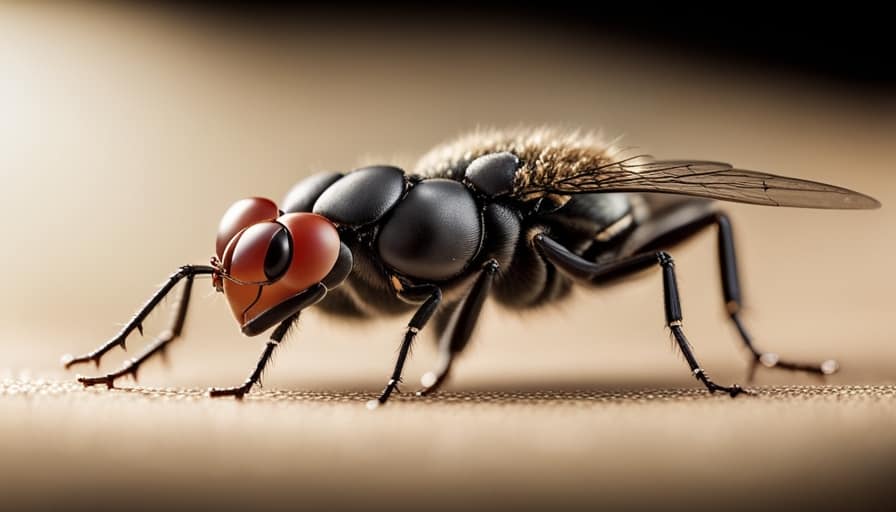
Throughout the process, the architect provided valuable insights and suggestions, helping me make informed decisions. Finding inspiration was also crucial, and the architect shared various sources, such as magazines, websites, and architectural books, which helped me visualize different design elements.
Collaborating with an architect gave me the confidence that my tiny house plans would be customized to my exact specifications while meeting building regulations and codes.
Utilizing Online Resources and Communities
By searching through online forums and joining social media groups, I was able to find a wealth of information and connect with a supportive community of tiny house enthusiasts. These online resources provided a platform for sharing tiny house design ideas and exploring alternative construction methods.
I discovered numerous websites and blogs dedicated to tiny house living, where individuals shared their own plans, designs, and experiences. Through these online communities, I was able to learn about various construction techniques, such as using reclaimed materials or incorporating off-grid systems.

The discussions and interactions with other members of the community were invaluable in helping me refine my own tiny house plans and make informed decisions. Utilizing these online resources and communities allowed me to tap into a vast pool of knowledge and creativity, ultimately leading me to collaborate with a tiny house builder who could bring my vision to life.
Collaborating With a Tiny House Builder
Fortunately, I was able to successfully collaborate with a talented tiny house builder who shared my vision and could bring my dream home to life. Collaborating with a contractor is crucial in ensuring that your tiny house is built to your specifications and meets all the necessary building codes.
Here are some key steps I took in finding a tiny house builder:
- Research: I conducted thorough research online and through word-of-mouth to find reputable builders with a track record of constructing quality tiny homes.
- Interviews: I interviewed multiple builders to assess their expertise, experience, and ability to understand my specific needs. This allowed me to gauge their level of professionalism and determine if they were a good fit for my project.
- Portfolio review: I carefully reviewed each builder’s portfolio to see examples of their previous work and assess their craftsmanship and attention to detail.
DIY Approach: Creating Your Own Plans
I decided to take matters into my own hands and create my own plans for my tiny house.

To begin, I utilized design software to bring my vision to life. This software allowed me to create detailed and precise floor plans, 3D models, and even visualize the interior and exterior of my future home.
While designing, I also sought professional advice to ensure that my plans met safety standards and were structurally sound. Consulting with architects, engineers, and experienced builders provided me with valuable insights and recommendations.
Their expertise helped me refine my design and address any potential issues. It was a challenging process, but the satisfaction of creating something unique and tailored to my needs made it all worthwhile.
Frequently Asked Questions
How Much Does It Cost to Purchase Pre-Made Tiny House Plans?
It costs around $500 to $2,000 to purchase pre-made tiny house plans. The advantages of pre-made plans include saving time and having a professional design. Custom plans can cost more but offer greater personalization.

Can I Make Modifications to Pre-Made Plans?
Yes, I can make modifications to pre-made plans. I find inspiration for modifications by researching online, visiting other tiny houses, and attending workshops. It’s an exciting process that allows me to customize my home.
Are There Any Online Resources or Communities Where I Can Find Free Tiny House Plans?
Yes, there are online communities and DIY resources where you can find free tiny house plans. These platforms provide a wealth of information and support for those looking to build their own tiny homes.
How Much Does It Typically Cost to Collaborate With a Tiny House Builder to Create Custom Plans?
Collaborating with a tiny house builder for custom plans typically costs around $1,500 to $3,000, depending on the complexity of the design. This allows for extensive customization options to suit specific needs and preferences.
What Are the Essential Factors to Consider When Creating Your Own Tiny House Plans From Scratch?
When creating my own tiny house plans from scratch, I consider factors like space optimization, energy efficiency, and structural integrity. The design process involves careful measurements, detailed drawings, and constant revisions to ensure a functional and aesthetic living space.

Conclusion
After exploring various options for obtaining tiny house plans, I’ve come to realize that the process is as diverse as the tiny house community itself. Whether you decide to purchase pre-made plans, work with an architect, utilize online resources, collaborate with a builder, or take on the DIY approach, there’s a wealth of information and support available.
Like a compass guiding you through uncharted waters, these plans will be your blueprint to a unique and fulfilling tiny house journey.
I’m Theodore, and I love tiny houses. In fact, I’m the author of Tiny House 43, a book about tiny houses that are also tree houses. I think they’re magical places where imaginations can run wild and adventures are just waiting to happen.
While tree houses are often associated with childhood, they can be the perfect adult retreat. They offer a cozy space to relax and unwind, surrounded by nature. And since they’re typically built on stilts or raised platforms, they offer stunning views that traditional homes simply can’t match.
If you’re looking for a unique and romantic getaway, a tree house tiny house might just be the perfect option.
Beginners Guides
How Do I Get Rid of Tiny White Bugs on My House Plants

- Health risks associated with tiny white bugs on house plants.
- Effective methods to prevent infestations of tiny white bugs on house plants
I am facing a small white insect issue with my indoor plants, and it is really frustrating me! These annoying bugs seem to be multiplying quickly, causing damage to my precious plants.
But fear not, my fellow plant enthusiasts, for I’ve done my research and found some effective solutions to eliminate these unwelcome guests.
In this article, I’ll share with you the knowledge and remedies I’ve discovered, so you too can reclaim your bug-free, thriving indoor garden.
Key Takeaways
- Aphids, mealybugs, and whiteflies are common types of tiny white bugs found on house plants.
- Lack of proper plant care, overwatering, and bringing infested plants indoors can lead to bug infestations.
- Homemade insecticides using water and dish soap or neem oil can suffocate and disrupt the feeding patterns of pests.
- Regular cleaning and inspection routines help detect and address pest issues early on.
Identifying the Tiny White Bugs on Your House Plants
I can easily spot the tiny white bugs on my house plants by carefully examining the leaves and stems. The most common species of these pests found on house plants are aphids, mealybugs, and whiteflies.

Aphids are small, pear-shaped insects that cluster on new leaves and buds.
Mealybugs are covered in a white, waxy substance and can be found on the undersides of leaves and in leaf axils.
Whiteflies, as the name suggests, are tiny white insects that fly around when disturbed.
An infestation of these tiny white bugs can cause significant damage to your house plants. Signs of infestation include yellowing leaves, stunted growth, distorted foliage, and a sticky residue called honeydew on the leaves. Furthermore, these pests can transmit plant diseases, weaken the plant’s immune system, and attract other pests.

Understanding the causes of infestation is crucial in effectively getting rid of these tiny white bugs on your house plants.
Understanding the Causes of Infestation
Understanding the causes of infestation is essential in effectively eliminating these tiny white bugs on my house plants. Here are a few key factors to consider:
- Lack of proper plant care: Neglecting to provide adequate water, sunlight, and nutrients can weaken plants, making them more susceptible to bug infestations.
- Overwatering: Excessive moisture can create a favorable environment for pests like aphids and mealybugs.
- Bringing infested plants indoors: Introducing plants from outside without proper inspection can bring unwanted bugs into your home.
Recognizing the signs of bug damage is crucial for preventing infestation. Look out for yellowing, wilting leaves, sticky residue on leaves and stems, and tiny white bugs crawling on the plant’s surface.
Now that we understand the causes of infestation, let’s explore natural remedies to eliminate these pesky bugs.

Natural Remedies to Eliminate the Bugs
To effectively get rid of these tiny white bugs on my house plants, I’ll need to rely on natural remedies that can eliminate them without harming the plants.
One effective option is to create homemade insecticides using ingredients readily available in your kitchen. You can mix a solution of water and dish soap, or water and neem oil, and spray it directly on the affected plants. These solutions work by suffocating the pests and disrupting their feeding patterns.
Another natural approach is to introduce insect-repelling plants into your garden. Plants like lavender, mint, and marigold emit fragrances that repel insects, keeping them away from your precious plants.
Chemical Solutions for a Lasting Bug-Free Environment
One effective chemical solution for achieving a bug-free environment is using a professional-grade insecticide spray. These sprays are specifically formulated to target and eliminate pests, including tiny white bugs on house plants. When using a professional-grade insecticide spray, it’s important to follow the instructions provided by the manufacturer to ensure safe and effective use.

Additionally, consider these non-toxic alternatives to chemical solutions for pest control:
-
Neem oil: Derived from the neem tree, neem oil is a natural insecticide that can be effective against a wide range of pests. It works by disrupting the insect’s life cycle and repelling them from plants.
-
Insecticidal soap: Made from potassium salts of fatty acids, insecticidal soap works by suffocating pests on contact. It’s safe to use on most plants and can be an effective solution against white bugs.
-
Diatomaceous earth: This powdery substance is made from fossilized remains of diatoms and acts as a desiccant, drying out and killing insects.

When using any chemical solution or non-toxic alternative, it’s essential to monitor the plants closely and repeat the treatment as necessary to maintain a bug-free environment. Professional pest control services can also provide expert guidance and assistance in achieving long-lasting results.
Preventing Future Infestations and Maintaining Healthy House Plants
To effectively prevent future infestations and maintain healthy house plants, I will implement a regular cleaning and inspection routine. This will help ensure that any signs of pests or diseases are detected early on and addressed promptly. Regularly cleaning the leaves and stems of my plants with a mild soap and water solution will help remove any dust or debris that can attract pests. Additionally, I will inspect the plants for any signs of infestation, such as white bugs or sticky residue on the leaves. To further enhance plant hygiene, I will also consider using beneficial insects, such as ladybugs or lacewings, which feed on common plant pests like aphids. By incorporating these practices into my routine, I can maintain healthy house plants and prevent future infestations.
| Regular Cleaning | Inspection Routine | Using Beneficial Insects |
| Remove dust and debris | Check for signs of infestation | Introduce ladybugs or lacewings to control pests |
| Promotes plant hygiene | Detect and address issues early | Natural pest control method |
| Prevents pest attraction | Maintain healthy house plants | Encourages ecosystem balance |
Frequently Asked Questions
Can These Tiny White Bugs Harm Humans?
Yes, tiny white bugs on house plants can harm humans. They can cause skin irritations and allergic reactions. It’s important to take steps to prevent infestations, such as regularly inspecting and cleaning your plants.
How Long Does It Take for Natural Remedies to Eliminate the Bugs Completely?
To completely eliminate the tiny white bugs using natural remedies, it typically takes a few weeks of consistent application. However, the effectiveness of these remedies can vary. It’s important to avoid common mistakes like under-applying or using incorrect remedies.

Are There Any Specific Types of House Plants That Are More Prone to Infestations?
Certain house plants, like lavender and marigolds, have natural repellent properties that can help prevent infestations. It’s important to choose plants that are known to repel bugs and to regularly inspect and clean your plants to avoid any potential infestations.
Can These Bugs Spread From One House Plant to Another?
Oh, the joy of tiny white bugs on house plants! Yes, these pests can spread from one plant to another. To control them, use insecticides and watch out for signs of infestation like sticky residue or wilting leaves.
How Often Should I Check My House Plants for Signs of Infestation?
I check my house plants for signs of infestation regularly to ensure their health. Common signs include tiny white bugs and yellowing leaves. Preventative measures like proper watering and cleaning can help keep plants bug-free.
Conclusion
In conclusion, taking care of our house plants goes beyond watering and sunlight. Identifying and eliminating tiny white bugs is a crucial part of maintaining a healthy environment for our plants.

By understanding the causes of infestation and using natural or chemical remedies, we can ensure a bug-free environment. Remember, prevention is key, so regularly inspect your plants and take necessary measures to keep them thriving.
Happy gardening!
I’m Theodore, and I love tiny houses. In fact, I’m the author of Tiny House 43, a book about tiny houses that are also tree houses. I think they’re magical places where imaginations can run wild and adventures are just waiting to happen.
While tree houses are often associated with childhood, they can be the perfect adult retreat. They offer a cozy space to relax and unwind, surrounded by nature. And since they’re typically built on stilts or raised platforms, they offer stunning views that traditional homes simply can’t match.
If you’re looking for a unique and romantic getaway, a tree house tiny house might just be the perfect option.
Beginners Guides
How Do I Get Rid of Tiny Moths in My House

I have experienced the frustration of dealing with tiny moths flying around my food in the kitchen. But do not worry, I have a solution for you.
In this article, I’ll show you how to banish those pesky moths from your house for good. We’ll dive into identifying different moth species, understanding what attracts them, and simple prevention techniques you can implement.
Plus, I’ll share some natural remedies and professional options as a last resort. Say goodbye to those unwanted guests!
Key Takeaways
- Identifying the specific moth species is crucial for implementing targeted control measures.
- Moths are attracted to food sources, fabrics, and organic materials, so it’s important to store food in airtight containers and keep the house clean.
- Moths prefer dark, undisturbed areas to lay their eggs, so sealing cracks and openings in walls, windows, and doors can help prevent infestation.
- If natural remedies and DIY methods fail, it is advisable to seek professional pest control services for thorough inspection and tailored treatment plans.
Identifying the Culprits: What Type of Moth Is Invading Your Home
I can’t figure out what kind of moth is infesting my home. It’s frustrating not knowing the exact species, as different moths have different behaviors and habits. Identifying the culprits is crucial in order to effectively address the problem.

There are several common moth species that are known to invade homes, such as the Indian mealmoth, clothes moth, and pantry moth. Each species has distinct characteristics that can help with identification. Understanding their behavior is also important as it can give insights into their lifecycle and potential sources of infestation.
Moths are attracted to food sources, fabrics, and other organic materials. They can lay eggs in stored grains, textiles, or even pet food. By understanding the specific species and their behavior, it becomes easier to implement targeted control measures and prevent further infestations.
Understanding the Infestation: Why Are Moths Attracted to Your House
To effectively address the infestation, it’s essential to understand why moths are attracted to your house. Here are four reasons why moths may be flocking to your home:
-
Food sources: Moths are attracted to food, especially grains, cereals, and dried fruits. They can easily find their way into your pantry and feast on these items.

-
Moisture and humidity: Moths thrive in damp environments, making your house an ideal breeding ground if there are areas with high humidity or water leaks.
-
Suitable habitat: Moths are drawn to dark, undisturbed areas where they can lay their eggs undisturbed. This includes closets, attics, and basements.
-
Outdoor attraction: Moths can be attracted to your house from the outside, especially if you have outdoor lights that are left on at night.
Understanding moth behavior and their attraction to your house is crucial in preventing further infestation. By addressing these factors, you can take steps to keep moths at bay and protect your home.

Here are some moth prevention tips:
- Store food in airtight containers.
- Keep your house clean and free of crumbs or spills.
- Fix any leaks or moisture issues promptly.
- Use moth repellents or traps in vulnerable areas.
Prevention Is Key: Simple Steps to Keep Moths From Entering Your Home
Prevention is essential, so I’ll share some simple steps to keep moths from entering your home. By taking a proactive approach, you can create an inhospitable environment for moths and minimize the risk of infestations. One effective method is to use moth repellent products, such as sachets or sprays, in areas where moths are commonly found. These repellents contain chemicals that deter moths from entering your home. Additionally, it is crucial to seal any cracks or openings in your walls, windows, and doors. Moths can easily slip through these tiny gaps, so using caulk or weatherstripping can help keep them out. Regularly vacuuming and cleaning your home can also eliminate moth eggs or larvae that may be hiding in carpets or corners. By implementing these preventive measures, you can ensure a moth-free home environment.
| Steps to Keep Moths Away | |
|---|---|
| Use moth repellent products | Seal cracks and openings |
| Regularly vacuum and clean |
Natural Remedies: Non-Toxic Solutions to Get Rid of Moths
One effective way to get rid of moths naturally is by using a combination of vinegar and water to create a non-toxic moth spray. Here are some natural remedies you can try:
-
Vinegar and water spray: Mix equal parts vinegar and water in a spray bottle. Spray this solution on areas where moths are present, such as closets, drawers, and pantry shelves. The strong odor of vinegar repels moths and prevents them from laying eggs.
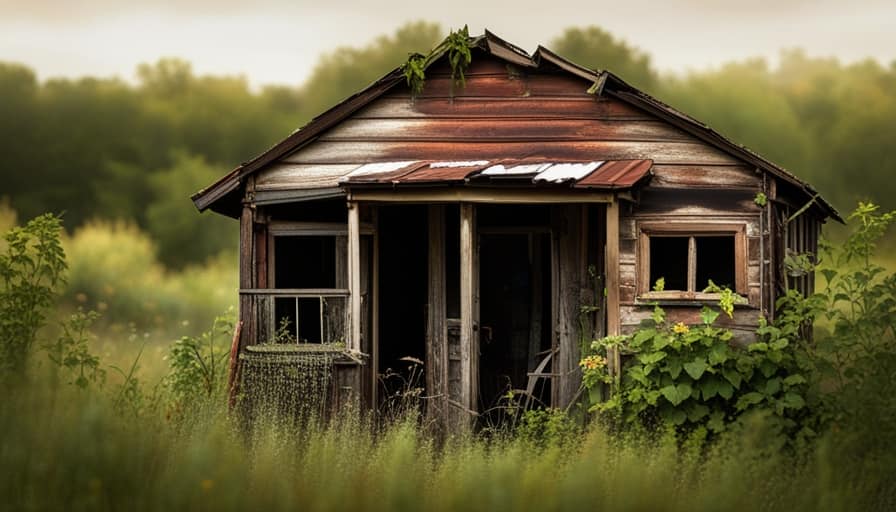
-
Cedar chips: Moths dislike the smell of cedar, so placing cedar chips in your closets and drawers can help deter them. You can also use cedar oil or cedar sachets for the same effect.
-
Homemade traps: Create simple moth traps by placing a mixture of vinegar, sugar, and dish soap in a bowl. The sweet scent attracts moths, and the dish soap traps them when they try to land on the mixture.
-
Lavender sachets: Moths are repelled by the fragrance of lavender. Place dried lavender in small sachets and tuck them in your clothing drawers or hang them in your closets.
These natural repellents and homemade traps can help you get rid of moths without using toxic chemicals. However, if these methods fail to eliminate the infestation, it may be time to consider professional pest control options.

Last Resort: When All Else Fails, Professional Pest Control Options
If I’ve exhausted all other options, I’ll contact a professional pest control service to eliminate the moth infestation in my house. While natural remedies and DIY methods can be effective for small infestations, sometimes the problem persists or worsens despite our best efforts.
This is when it’s crucial to call in the experts. Professional pest control services have the knowledge, experience, and resources to effectively eradicate moth infestations. They’ll conduct a thorough inspection of your home to identify the source of the infestation and develop a tailored treatment plan.
The benefits of hiring professionals include their expertise in identifying different moth species, their access to specialized equipment and pesticides, and their ability to ensure the complete eradication of the infestation.
When all else fails, it’s best to rely on the expertise of professional pest control services to rid your home of those persistent moths.

Frequently Asked Questions
Can Moths Cause Any Damage to My House or Belongings?
Moths can cause damage to fabrics, carpets, and stored food. It’s important to address a moth infestation promptly. Using natural moth repellents, like lavender or cedar, can help deter them from your house and protect your belongings.
Are All Types of Moths Attracted to Homes, or Are There Specific Species That Are More Common?
In the world of moths, certain species have a penchant for our cozy homes. Understanding the types commonly found indoors can help us prevent the dreaded infestations from taking hold in the first place.
How Long Does It Usually Take to Get Rid of a Moth Infestation Using Natural Remedies?
Using natural remedies to get rid of a moth infestation can be effective, but the time it takes varies depending on the severity. Common signs of an infestation include sightings of adult moths and larvae, as well as damaged fabrics or food products.
Can Moths Carry Diseases or Pose a Health Risk to Humans?
Moths can transmit diseases to humans, so it’s important to take precautions. Individuals with allergies or asthma may experience respiratory issues due to moth infestations in homes.

Are There Any Specific Plants or Herbs That Repel Moths and Can Be Used as Natural Remedies?
Using natural moth repellents, such as specific plants and herbs, offers several benefits over chemical alternatives. Creating a moth repelling garden with lavender, rosemary, and mint can effectively deter moths from your house.
Conclusion
In conclusion, it’s essential to address the presence of these minuscule pests in your home promptly. By identifying the specific type of moth invading your space and understanding their attraction, you can take preventive measures to keep them at bay.
Utilizing natural remedies and seeking professional pest control services as a last resort will ensure a moth-free environment without compromising your household’s well-being.
Stay vigilant and employ these effective methods to bid farewell to these unwelcome visitors.

I’m Theodore, and I love tiny houses. In fact, I’m the author of Tiny House 43, a book about tiny houses that are also tree houses. I think they’re magical places where imaginations can run wild and adventures are just waiting to happen.
While tree houses are often associated with childhood, they can be the perfect adult retreat. They offer a cozy space to relax and unwind, surrounded by nature. And since they’re typically built on stilts or raised platforms, they offer stunning views that traditional homes simply can’t match.
If you’re looking for a unique and romantic getaway, a tree house tiny house might just be the perfect option.
-

 Beginners Guides2 weeks ago
Beginners Guides2 weeks agoHow To Buy A Tesla Tiny House
-

 Energy Efficiency2 months ago
Energy Efficiency2 months agoBest Tiny Homes For Cold Climates
-

 Beginners Guides1 week ago
Beginners Guides1 week agoTiny House Nation Where Are They Now Stephanie
-

 Tiny House Resources (e.g., legalities, cost, insurance, FAQs)2 months ago
Tiny House Resources (e.g., legalities, cost, insurance, FAQs)2 months agoDo Tiny Homes Need Planning Permission?
-

 Beginners Guides3 weeks ago
Beginners Guides3 weeks agoFrom The Show Tiny House Nation How Many Keep Their Tiny House?
-

 Beginners Guides2 months ago
Beginners Guides2 months agoUsing a Climbing Net For Treehouse Construction
-

 Beginners Guides2 months ago
Beginners Guides2 months agoHow to Build a Treehouse Without Drilling Into the Tree
-

 Beginners Guides3 weeks ago
Beginners Guides3 weeks agoTiny House Nation Who Pays For The Houses





